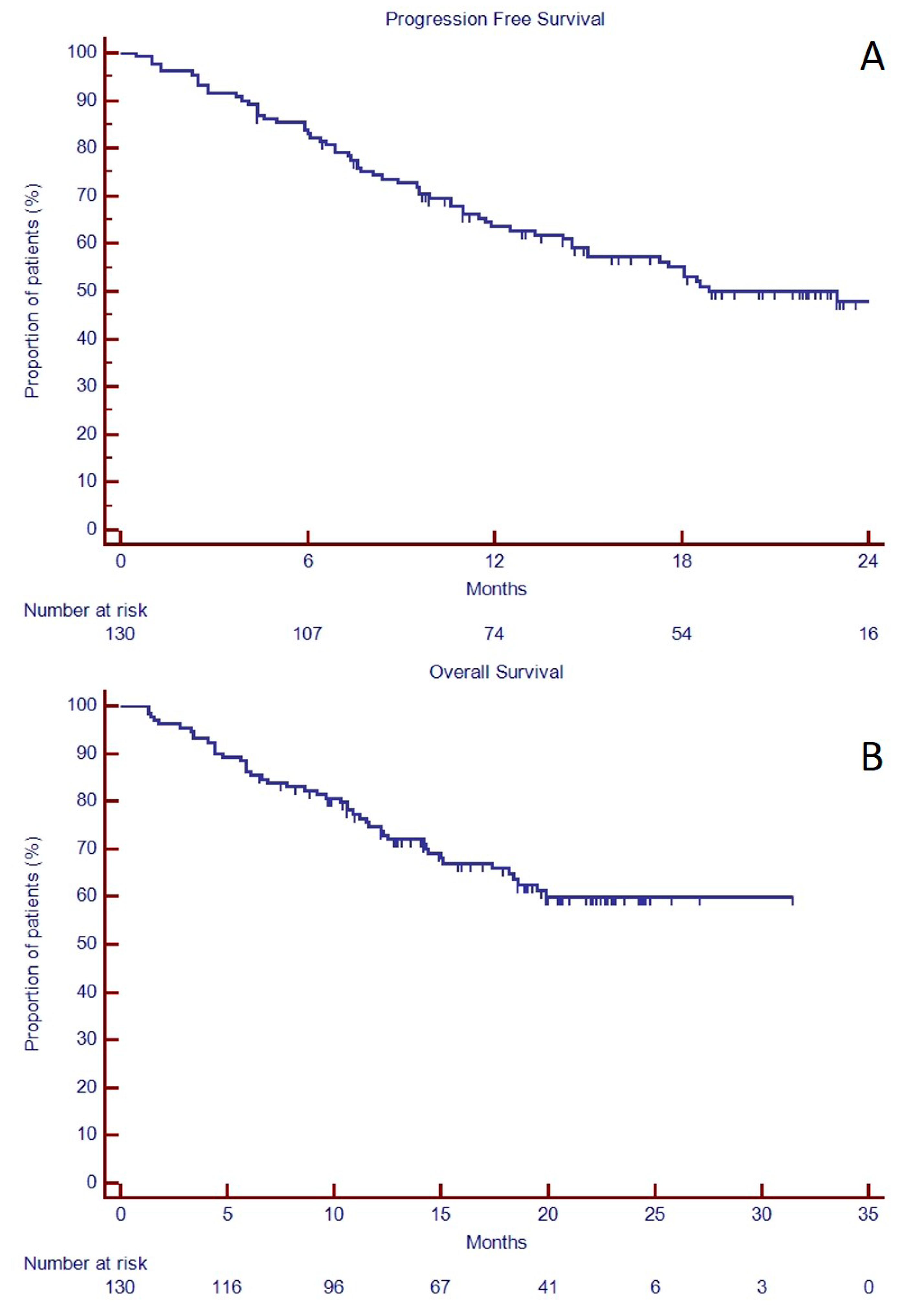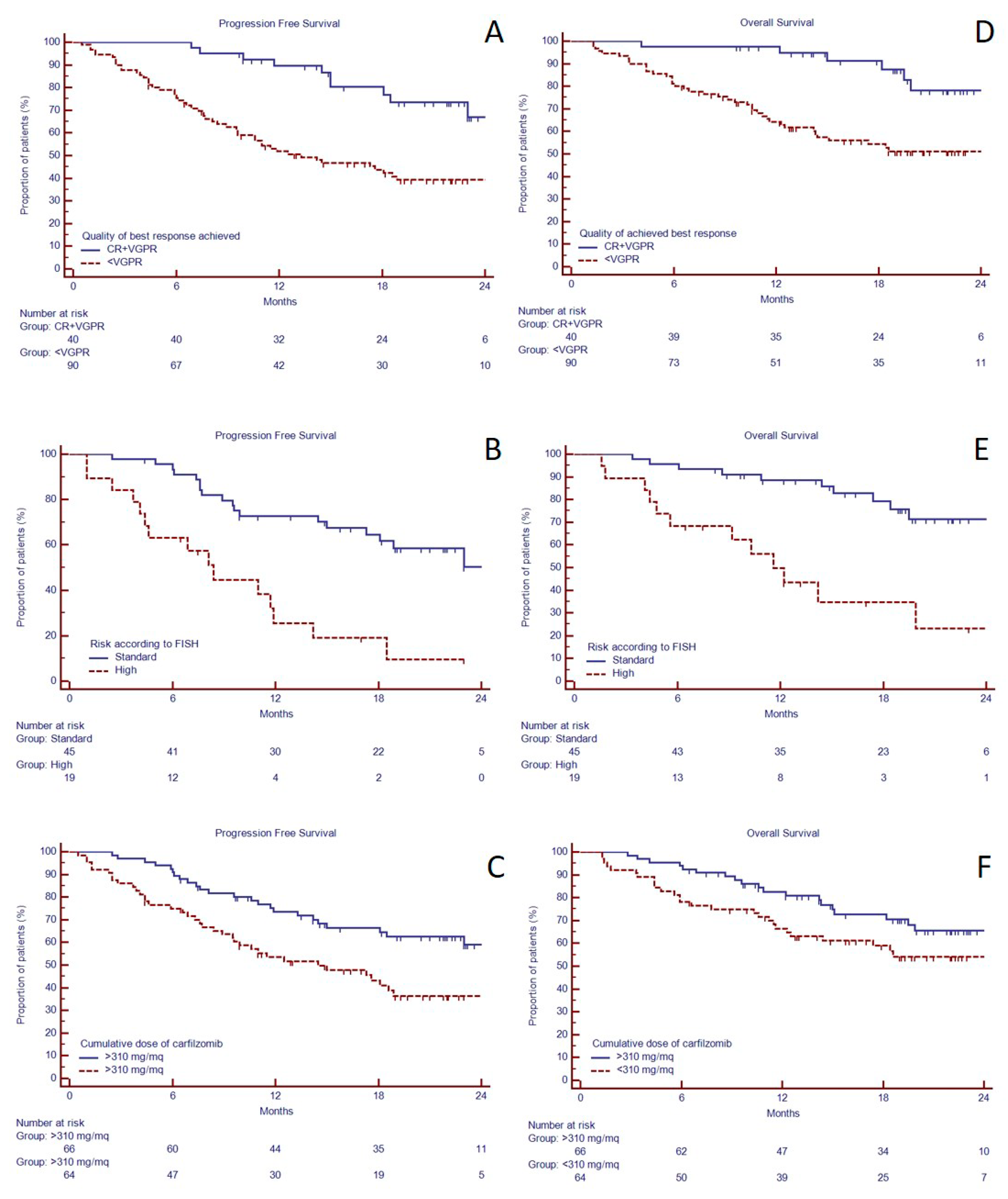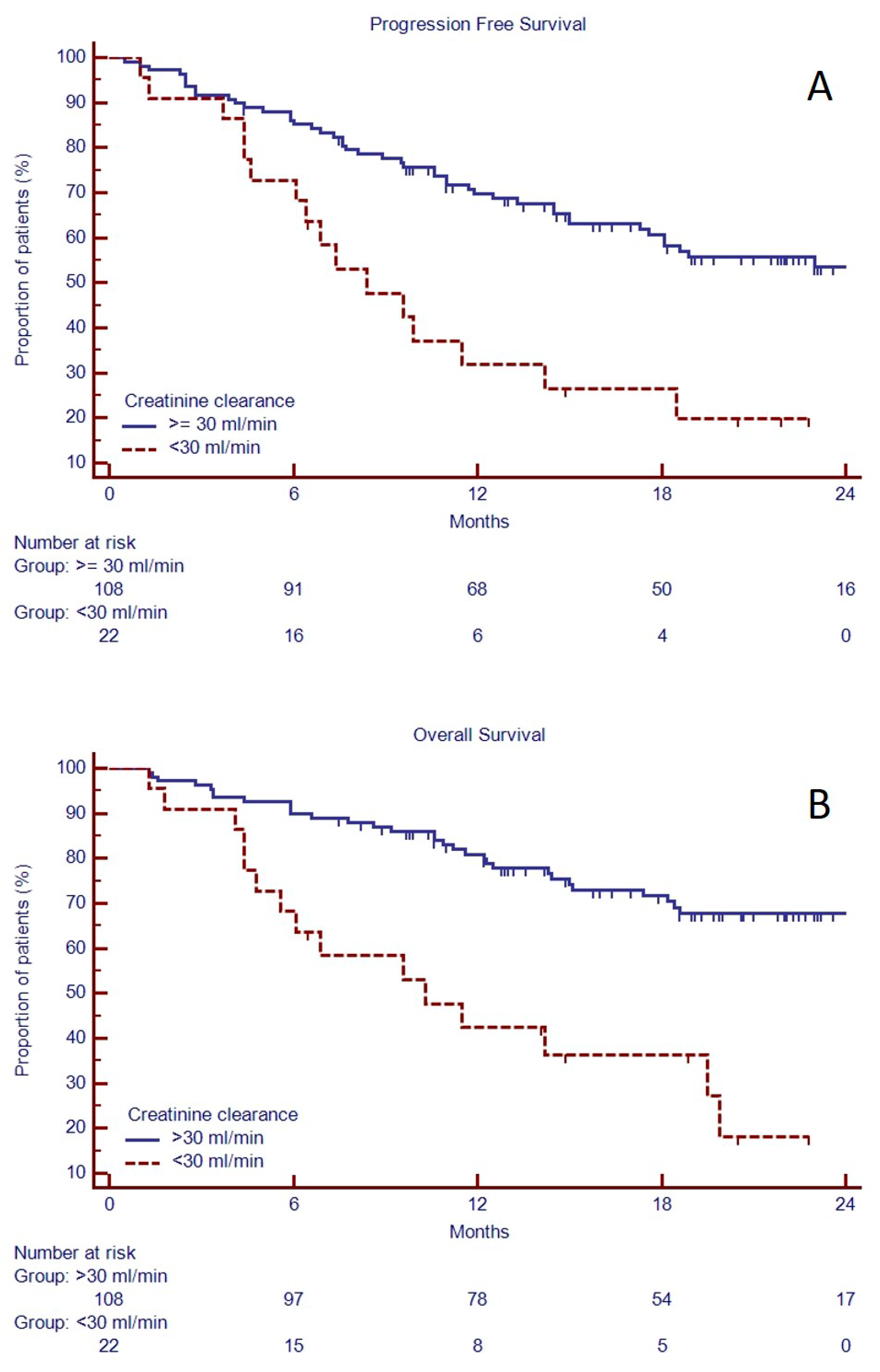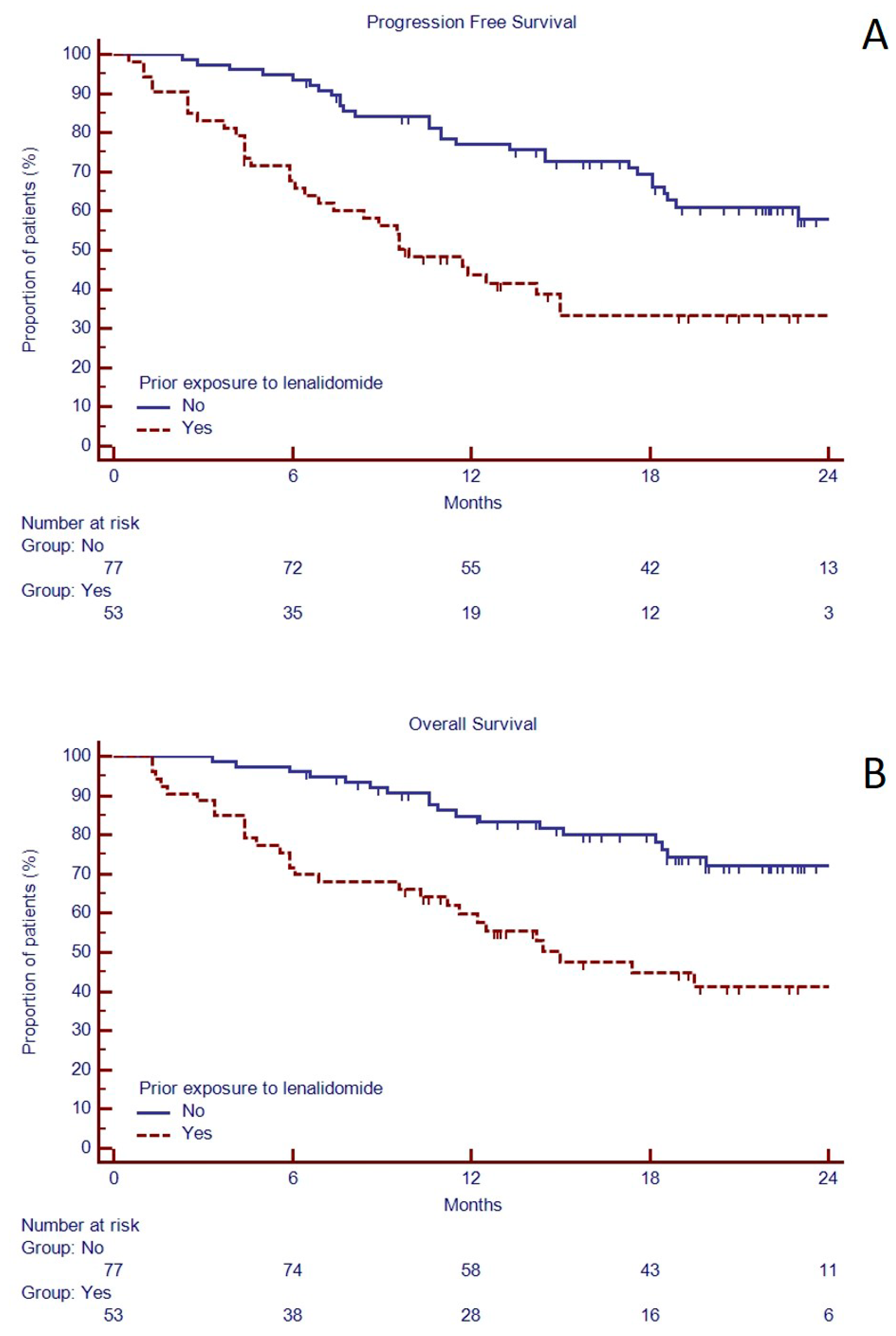Feasibility, Tolerability and Efficacy of Carfilzomib in Combination with Lenalidomide and Dexamethasone in Relapsed Refractory Myeloma Patients: A Retrospective Real-Life Survey of the Sicilian Myeloma Network
Abstract
1. Introduction
2. Methods
2.1. Patient Selection
2.2. Procedures and Drug Administration
2.3. Concomitant Medications
2.4. Safety and Efficacy Assessment
2.5. Statistical Analysis
3. Results
3.1. Patients’ Characteristics and Treatment
3.2. Safety
3.3. Efficacy
3.4. Predictors of Outcome of KRd in the Real-Life Setting
4. Discussion
5. Conclusions
Supplementary Materials
Author Contributions
Acknowledgments
Conflicts of Interest
References
- Kumar, S.K.; Lee, J.H.; Lahuerta, J.J.; Morgan, G.; Richardson, P.G.; Crowley, J.; Haessler, J.; Feather, J.; Hoering, A.; Moreau, P.; et al. Risk of progression and survival in multiple myeloma relapsing after therapy with IMiDs and bortezomib: A multicenter international myeloma working group study. Leukemia 2012, 26, 149–157. [Google Scholar] [CrossRef] [PubMed]
- Dimopoulos, M.A.; Moreau, P.; Palumbo, A.; Joshua, D.; Pour, L.; Hájek, R.; Facon, T.; Ludwig, H.; Oriol, A.; Goldschmidt, H.; et al. Carfilzomib and dexamethasone versus bortezomib and dexamethasone for patients with relapsed or refractory multiple myeloma (ENDEAVOR): A randomised, phase 3, open-label, multicentre study. Lancet Oncol. 2016, 17, 27–38. [Google Scholar] [CrossRef]
- San-Miguel, J.F.; Hungria, V.T.; Yoon, S.S.; Beksac, M.; Dimopoulos, M.A.; Elghandour, A.; Jedrzejczak, W.W.; Günther, A.; Nakorn, T.N.; Siritanaratkul, N.; et al. Panobinostat plus bortezomib and dexamethasone versus placebo plus bortezomib and dexamethasone in patients with relapsed or relapsed and refractory multiple myeloma: A multicentre, randomised, double-blind phase 3 trial. Lancet Oncol. 2014, 15, 1195–1206. [Google Scholar] [CrossRef]
- Palumbo, A.; Chanan-Khan, A.; Weisel, K.; Nooka, A.K.; Masszi, T.; Beksac, M.; Spicka, I.; Hungria, V.; Munder, M.; Mateos, M.V.; et al. Daratumumab, Bortezomib, and Dexamethasone for Multiple Myeloma. N. Engl. J. Med. 2016, 375, 754–766. [Google Scholar] [CrossRef] [PubMed]
- Stewart, A.K.; Rajkumar, S.V.; Dimopoulos, M.A.; Masszi, T.; Špička, I.; Oriol, A.; Hájek, R.; Rosiñol, L.; Siegel, D.S.; Mihaylov, G.G.; et al. Carfilzomib, lenalidomide, and dexamethasone for relapsed multiple myeloma. N. Engl. J. Med. 2015, 372, 142–152. [Google Scholar] [CrossRef] [PubMed]
- Moreau, P.; Masszi, T.; Grzasko, N.; Bahlis, N.J.; Hansson, M.; Pour, L.; Sandhu, I.; Ganly, P.; Baker, B.W.; Jackson, S.R.; et al. Oral Ixazomib, Lenalidomide, and Dexamethasone for Multiple Myeloma. N. Engl. J. Med. 2016, 374, 1621–1634. [Google Scholar] [CrossRef]
- Lonial, S.; Dimopoulos, M.; Palumbo, A.; White, D.; Grosicki, S.; Spicka, I.; Walter-Croneck, A.; Moreau, P.; Mateos, M.V.; Magen, H.; et al. Elotuzumab Therapy for Relapsed or Refractory Multiple Myeloma. N. Engl. J. Med. 2015, 373, 621–631. [Google Scholar] [CrossRef]
- Dimopoulos, M.A.; Oriol, A.; Nahi, H.; San-Miguel, J.; Bahlis, N.J.; Usmani, S.Z.; Rabin, N.; Orlowski, R.Z.; Komarnicki, M.; Suzuki, K.; et al. Daratumumab, Lenalidomide, and Dexamethasone for Multiple Myeloma. N. Engl. J. Med. 2016, 375, 1319–1331. [Google Scholar] [CrossRef]
- Siegel, D.S.; Dimopoulos, M.A.; Ludwig, H.; Facon, T.; Goldschmidt, H.; Jakubowiak, A.; San-Miguel, J.; Obreja, M.; Blaedel, J.; Stewart, A.K. Improvement in Overall Survival With Carfilzomib, Lenalidomide, and Dexamethasone in Patients With Relapsed or Refractory Multiple Myeloma. J. Clin. Oncol. 2018, 36, 728–734. [Google Scholar] [CrossRef]
- Yong, K.; Delforge, M.; Driessen, C.; Fink, L.; Flinois, A.; Gonzalez-McQuire, S.; Safaei, R.; Karlin, L.; Mateos, M.V.; Raab, M.S.; et al. Multiple myeloma: Patient outcomes in real-world practice. Br. J. Haematol. 2016, 175, 252–264. [Google Scholar] [CrossRef]
- Maciocia, N.; Melville, A.; Cheesman, S.; Sharpley, F.; Ramasamy, K.; Streetly, M.; Jenner, M.; Benjamin, R.; Schey, S.; Maciocia, P.; et al. Real-world use of pomalidomide and dexamethasone in double refractory multiple myeloma suggests benefit in renal impairment and adverse genetics: A multi-centre UK experience. Br. J. Haematol. 2017, 176, 908–917. [Google Scholar] [CrossRef]
- Romano, A.; Conticello, C.; Cavalli, M.; Vetro, C.; Di Raimondo, C.; Di Martina, V.; Schinocca, E.; La Fauci, A.; Parrinello, N.L.; Chiarenza, A.; et al. Salvage therapy of multiple myeloma: The new generation drugs. Biomed. Res. Int. 2014, 2014, 456037. [Google Scholar] [CrossRef] [PubMed]
- Rizzo, J.D.; Brouwers, M.; Hurley, P.; Seidenfeld, J.; Somerfield, M.R.; Temin, S. American Society of Clinical Oncology/American Society of Hematology clinical practice guideline update on the use of epoetin and darbepoetin in adult patients with cancer. J. Clin. Oncol. 2010, 28, 317–320. [Google Scholar] [CrossRef] [PubMed]
- Aapro, M.S.; Bohlius, J.; Cameron, D.A.; Dal Lago, L.; Donnelly, J.P.; Kearney, N.; Lyman, G.H.; Pettengell, R.; Tjan-Heijnen, V.C.; Walewski, J.; et al. 2010 update of EORTC guidelines for the use of granulocyte-colony stimulating factor to reduce the incidence of chemotherapy-induced febrile neutropenia in adult patients with lymphoproliferative disorders and solid tumours. Eur. J. Cancer 2011, 47, 8–32. [Google Scholar] [CrossRef] [PubMed]
- TThanarajasingam, G.; Minasian, L.M.; Baron, F.; Cavalli, F.; De Claro, R.A.; Dueck, A.C.; El-Galaly, T.C.; Everest, N.; Geissler, J.; Gisselbrecht, C.; et al. Beyond maximum grade: Modernising the assessment and reporting of adverse events in haematological malignancies. Lancet Haematol. 2018, 5, e563–e598. [Google Scholar] [CrossRef]
- Kumar, S.; Paiva, B.; Anderson, K.C.; Durie, B.; Landgren, O.; Moreau, P.; Munshi, N.; Lonial, S.; Bladé, J.; Mateos, M.V.; et al. International Myeloma Working Group consensus criteria for response and minimal residual disease assessment in multiple myeloma. Lancet Oncol. 2016, 17, e328–e346. [Google Scholar] [CrossRef]
- Kyle, R.A.; Rajkumar, S.V. Criteria for diagnosis, staging, risk stratification and response assessment of multiple myeloma. Leukemia 2009, 23, 3–9. [Google Scholar] [CrossRef]
- Bringhen, S.; Milan, A.; Ferri, C.; Wäsch, R.; Gay, F.; Larocca, A.; Salvini, M.; Terpos, E.; Goldschmidt, H.; Cavo, M.; et al. Cardiovascular adverse events in modern myeloma therapy—Incidence and risks. A review from the European Myeloma Network (EMN) and Italian Society of Arterial Hypertension (SIIA). Haematologica 2018, 103, 1422–1432. [Google Scholar] [CrossRef]
- Mateos, M.V.; Richardson, P.G.; Dimopoulos, M.A.; Palumbo, A.; Anderson, K.C.; Shi, H.; Elliott, J.; Dow, E.; van de Velde, H.; Niculescu, L.; et al. Effect of cumulative bortezomib dose on survival in multiple myeloma patients receiving bortezomib-melphalan-prednisone in the phase III VISTA study. Am. J. Hematol. 2015, 90, 314–319. [Google Scholar] [CrossRef]
- Moreau, P.; Mateos, M.V.; Berenson, J.R.; Weisel, K.; Lazzaro, A.; Song, K.; Dimopoulos, M.A.; Huang, M.; Zahlten-Kumeli, A.; Stewart, A.K. Once weekly versus twice weekly carfilzomib dosing in patients with relapsed and refractory multiple myeloma (A.R.R.O.W.): Interim analysis results of a randomised, phase 3 study. Lancet Oncol. 2018, 19, 953–964. [Google Scholar] [CrossRef]
- Shah, C.; Bishnoi, R.; Wang, Y.; Zou, F.; Bejjanki, H.; Master, S.; Moreb, J.S. Efficacy and safety of carfilzomib in relapsed and/or refractory multiple myeloma: Systematic review and meta-analysis of 14 trials. Oncotarget 2018, 9, 23704–23717. [Google Scholar] [CrossRef] [PubMed]
- Dimopoulos, M.A.; Stewart, A.K.; Masszi, T.; Špička, I.; Oriol, A.; Hajek, R.; Rosiñol, L.; Siegel, D.; Mihaylov, G.G.; Goranova-Marinova, V.; et al. Carfilzomib-lenalidomide-dexamethasone vs lenalidomide-dexamethasone in relapsed multiple myeloma by previous treatment. Blood Cancer J. 2017, 7, e554. [Google Scholar] [CrossRef] [PubMed]
- Moreau, P.; Joshua, D.; Chng, W.J.; Palumbo, A.; Goldschmidt, H.; Hájek, R.; Facon, T.; Ludwig, H.; Pour, L.; Niesvizky, R.; et al. Impact of prior treatment on patients with relapsed multiple myeloma treated with carfilzomib and dexamethasone vs bortezomib and dexamethasone in the phase 3 ENDEAVOR study. Leukemia 2017, 31, 115–122. [Google Scholar] [CrossRef] [PubMed]
- McCarthy, P.L.; Holstein, S.A.; Petrucci, M.T.; Richardson, P.G.; Hulin, C.; Tosi, P.; Bringhen, S.; Musto, P.; Anderson, K.C.; Caillot, D.; et al. Lenalidomide Maintenance After Autologous Stem-Cell Transplantation in Newly Diagnosed Multiple Myeloma: A Meta-Analysis. J. Clin. Oncol. 2017, 35, 3279–3289. [Google Scholar] [CrossRef] [PubMed]
- MMcCarthy, P.L.; Owzar, K.; Hofmeister, C.C.; Hurd, D.D.; Hassoun, H.; Richardson, P.G.; Giralt, S.; Stadtmauer, E.A.; Weisdorf, D.J.; Vij, R.; et al. Lenalidomide after stem-cell transplantation for multiple myeloma. N. Engl. J. Med. 2012, 366, 770–1781. [Google Scholar] [CrossRef] [PubMed]
- Dimopoulos, M.A.; Delforge, M.; Hájek, R.; Kropff, M.; Petrucci, M.T.; Lewis, P.; Nixon, A.; Zhang, J.; Mei, J.; Palumbo, A. Lenalidomide, melphalan, and prednisone, followed by lenalidomide maintenance, improves health-related quality of life in newly diagnosed multiple myeloma patients aged 65 years or older: Results of a randomized phase III trial. Haematologica 2013, 98, 84–788. [Google Scholar] [CrossRef]
- Benboubker, L.; Dimopoulos, M.A.; Dispenzieri, A.; Catalano, J.; Belch, A.R.; Cavo, M.; Pinto, A.; Weisel, K.; Ludwig, H.; Bahlis, N.; et al. Lenalidomide and dexamethasone in transplant-ineligible patients with myeloma. N. Engl. J. Med. 2014, 371, 906–917. [Google Scholar] [CrossRef]
- Dimopoulos, M.; Kyle, R.; Fermand, J.P.; Rajkumar, S.V.; San Miguel, J.; Chanan-Khan, A.; Ludwig, H.; Joshua, D.; Mehta, J.; Gertz, M.; et al. Consensus recommendations for standard investigative workup: Report of the International Myeloma Workshop Consensus Panel 3. Blood 2011, 117, 701–4705. [Google Scholar] [CrossRef]
- Romano, A.; Chiarenza, A.; Consoli, U.; Conticello, C.; Forte, S.; Uccello, G.; Vetro, C.; Cavalli, M.; Coppolino, F.; Palumbo, G.A.; et al. Intravenous injection of bortezomib, melphalan and dexamethasone in refractory and relapsed multiple myeloma. Ann. Oncol. 2013, 24, 1038–1044. [Google Scholar] [CrossRef]
- Romano, A.; Chiarenza, A.; Conticello, C.; Cavalli, M.; Vetro, C.; Di Raimondo, C.; Cunsolo, R.; Palumbo, G.A.; Di Raimondo, F. Salvage therapy with pegylated liposomal doxorubicin, bortezomib, cyclophosphamide, and dexamethasone in relapsed/refractory myeloma patients. Eur. J. Haematol. 2014, 93, 207–213. [Google Scholar] [CrossRef]
- Facon, T.; Lee, J.H.; Moreau, P.; Niesvizky, R.; Dimopoulos, M.A.; Hajek, R.; Osman, M.; Aggarwal, S.; Klippel, Z.; San Miguel, J. Phase 3 Study (CLARION) of Carfilzomib, Melphalan, Prednisone (KMP) v Bortezomib, Melphalan, Prednisone (VMP) in Newly Diagnosed Multiple Myeloma (NDMM). Clin. Lymphoma Myeloma Leuk. 2017, 17, e26–e27. [Google Scholar] [CrossRef]




| Characteristics | 130 pts |
|---|---|
| Median age (range) | 62 (33–86) |
| Males/Females, n (%) | 73/57 (56/44) |
| Serum isotype | |
| IgG, n (%) | 77 (60) |
| IgA, n (%) | 25 (19) |
| IgM, n (%) | 1 (0.5) |
| Micromolecular, n (%) | 25 (19) |
| Non-secretory, n (%) | 2 (1) |
| ISS | |
| I, n (%) | 46 (35) |
| II, n (%) | 43 (33) |
| III, n (%) | 41 (32) |
| Durie and Salmon staging | |
| IA, n (%) | 33 (25) |
| IIA, n (%) | 15 (12) |
| IIB, n (%) | 4 (3) |
| IIIA, n (%) | 56 (43) |
| IIIB, n (%) | 10 (8) |
| Unknown, n (%) | 12 (9) |
| FISH analysis available | 64 (49) |
| Standard Risk, n (%) | 45 (70) |
| High risk, n (%) | 19 (30) |
| >3 bone lesions, n (%) | 70 (54) |
| Clearance creatinine <30 mL/min, n (%) Dialyzed patients, n (%) | 22 (17) 5 (4) |
| Extramedullary disease, n (%) | 4 (3) |
| Previous Regimens | |
|---|---|
| Median (range) | 2 (1–10) |
| 1–3 regimens | 114 (88) |
| ≥4 regimens | 16 (12) |
| Previous exposure to novel agents, pts n (%) | |
| Bortezomib | 126 (96) |
| Lenalidomide | 53 (40) |
| Thalidomide | 78 (60) |
| Pomalidomide | 16 (12) |
| ASCT (Autologous Stem Cell Transplant) | |
| Single | 40 (30) |
| Double | 40 (30) |
| No | 50 (38) |
| AlloSCT (Allogenic Stem Cell Transplant) | 3 (2) |
| Events | ||
|---|---|---|
| Hematological Toxicity | All Grades | 3–4 Grade |
| Anemia, n (%) | 46 (35) | 15 (12) |
| Neutropenia, n (%) | 32 (25) | 19 (15) |
| Piastrinopenia, n (%) | 39 (30) | 19 (15) |
| Non Hematological Toxicity | All Grades | 3–4 Grade |
| Gastrointestinal, n (%) | 40 (31) | 4 (3) |
| Pneumonia, n (%) | 37 (28) | 11 (8) |
| Cardiovascular, n (%) | 25 (19) | 11 (8) |
| Neurologic, n (%) | 20 (15) | 6 (5) |
| Fatigue, n (%) | 15 (12) | 2 (2) |
| Vascular, n (%) | 9 (7) | 6 (5) |
| Diabetes, n (%) | 2 (1) | 1 (1) |
| Cutaneous, n (%) | 8 (6) | 1 (1) |
| Pulmonary, n (%) | 4 (3) | 3 (2) |
| Ophthalmological, n (%) | 3 (2) | 0 (0) |
| ORL, n (%) | 9 (7) | 2 (2) |
| Musculoskeletal, n (%) | 7 (5) | 0 (0) |
| Hepatic, n (%) | 4 (3) | 2 (2) |
| Renal, n (%) | 2 (1) | 1 (1) |
| Best Response in Patients Who Received Less Than 18 Cycles | Best Response in Patients Who Received at Least 18 Cycles | Best Response of All Patients | |
|---|---|---|---|
| n = 109 (100%) | n = 21 (100%) | n = 130 (100%) | |
| ORR | 61 (55) | 18 (85) | 79 (60) |
| CR | 15 (14) | 9 (40) | 24 (18) |
| VGPR | 21 (19) | 4 (20) | 25 (19) |
| PR | 25 (22) | 5 (25) | 30 (23) |
| MR | 16 (15) | 2 (10) | 18 (14) |
| SD | 8 (7) | 1 (5) | 9 (7) |
| PD | 24 (22) | 0 (0) | 24 (19) |
| Univariate Analysis | Multivariate Analysis | Univariate Analysis | Multivariate Analysis | |||||||
|---|---|---|---|---|---|---|---|---|---|---|
| n | PFS @ 24 Months | p-Value | HR (95% CI) | p-Value | OS @ 24 Months | p-Value | HR (95% CI) | p-Value | ||
| Age | ≤65 | 68 | 50.5 | 0.66 | 66.4 | 0.12 | ||||
| >65 | 62 | 42.6 | 55.4 | |||||||
| Gender | male | 73 | 55.1 | 0.20 | 55.6 | 0.98 | ||||
| female | 57 | 38.1 | 62.8 | |||||||
| ISS | I–II | 95 | 50.4 | 0.14 | 60.8 | 0.37 | ||||
| III | 35 | 43.5 | 57.8 | |||||||
| Prior lines | 1–2 | 95 | 56.7 | 0.0001 | 1.78 (1.00–3.16) | 0.04 | 70.0 | 0.0002 | 1.81 (0.93–3.52) | 0.08 |
| more than 2 | 35 | 22.4 | 33.5 | |||||||
| Previous lenalidomide | no | 77 | 58.0 | 0.0001 | 0.79 (0.43–1.46) | 0.46 | 72.2 | 0.0001 | 1.84 (0.96–3.54) | 0.07 |
| yes | 53 | 33.3 | 41.4 | |||||||
| Previous pomalidomide | no | 114 | 51.2 | 0.02 | 1.34 (0.60–3.02) | 0.46 | 62.4 | 0.17 | ||
| yes | 16 | 24.2 | 42.2 | |||||||
| Previous BMT | no | 50 | 33.4 | 0.29 | 55.7 | 0.58 | ||||
| yes | 80 | 53.2 | 61.8 | |||||||
| Zoledronic acid exposure | no | 31 | 41.4 | 0.11 | 47.6 | 0.018 | 0.49 (0.26–0.94) | 0.03 | ||
| yes | 99 | 52.6 | 63.4 | |||||||
| Relapse | biochemical | 31 | 59.1 | 0.54 | 62.0 | 0.37 | ||||
| clinical | 99 | 47.6 | 52.6 | |||||||
| ClCr | <30 mL/min | 22 | 19.9 | 0.0003 | 3.34 (1.77–6.29) | 0.0002 | 18.2 | <0.0001 | 3.89 (1.87–8.07) | 0.0003 |
| >30mL/min | 108 | 53.5 | 67.7 | |||||||
| K Cumulative dose (2 cycles) | <310mg/mq | 64 | 36.4 | 0.006 | 1.40 (0.81–2.46) | 0.23 | 54.2 | 0.08 | ||
| >310mg/mq | 66 | 59.1 | 65.5 | |||||||
| Best response | <VGPR | 90 | 33.3 | 0.0002 | 3.19 (1.53–6.64) | 0.002 | 51.2 | 0.0008 | 4.50 (1.79–11.33) | 0.0015 |
| CR + VGPR | 40 | 66.9 | 78.0 | |||||||
| FISH risk * | Standard | 45 | 50.2 | <0.0001 | 4.28 * (2.09–8.79) | 0.0001 | 23.0 | 0.0001 | 4.18 * (1.92–9.11) | 0.0003 |
| High | 19 | 9.0 | 71.3 | |||||||
| Real Life Study | Aspire Trial | |
|---|---|---|
| Performance Status ECOG > 3 | 15% | 0 |
| Previous Lines median (range) | 2 (1–10) | 2 (1–3) |
| Creatinine ≤ 30 mL/min | 17% | 0 |
| Patients on Dialysis | 4% | 0 |
| Prior Lenalidomide exposure | 40% | 20% |
| High risk patients | 21% | 12% |
| Prior pomalidomide exposure | 12% | 0% |
| Prior ASCT | 60% | 56% |
© 2019 by the authors. Licensee MDPI, Basel, Switzerland. This article is an open access article distributed under the terms and conditions of the Creative Commons Attribution (CC BY) license (http://creativecommons.org/licenses/by/4.0/).
Share and Cite
Conticello, C.; Romano, A.; Del Fabro, V.; Martino, E.A.; Calafiore, V.; Sapienza, G.; Leotta, V.; Parisi, M.S.; Markovic, U.; Garibaldi, B.; et al. Feasibility, Tolerability and Efficacy of Carfilzomib in Combination with Lenalidomide and Dexamethasone in Relapsed Refractory Myeloma Patients: A Retrospective Real-Life Survey of the Sicilian Myeloma Network. J. Clin. Med. 2019, 8, 877. https://doi.org/10.3390/jcm8060877
Conticello C, Romano A, Del Fabro V, Martino EA, Calafiore V, Sapienza G, Leotta V, Parisi MS, Markovic U, Garibaldi B, et al. Feasibility, Tolerability and Efficacy of Carfilzomib in Combination with Lenalidomide and Dexamethasone in Relapsed Refractory Myeloma Patients: A Retrospective Real-Life Survey of the Sicilian Myeloma Network. Journal of Clinical Medicine. 2019; 8(6):877. https://doi.org/10.3390/jcm8060877
Chicago/Turabian StyleConticello, Concetta, Alessandra Romano, Vittorio Del Fabro, Enrica Antonia Martino, Valeria Calafiore, Giuseppe Sapienza, Valerio Leotta, Marina Silvia Parisi, Uros Markovic, Bruno Garibaldi, and et al. 2019. "Feasibility, Tolerability and Efficacy of Carfilzomib in Combination with Lenalidomide and Dexamethasone in Relapsed Refractory Myeloma Patients: A Retrospective Real-Life Survey of the Sicilian Myeloma Network" Journal of Clinical Medicine 8, no. 6: 877. https://doi.org/10.3390/jcm8060877
APA StyleConticello, C., Romano, A., Del Fabro, V., Martino, E. A., Calafiore, V., Sapienza, G., Leotta, V., Parisi, M. S., Markovic, U., Garibaldi, B., Leotta, S., Cotzia, E., Innao, V., Mannina, D., Neri, S., Musso, M., Scalone, R., Cangialosi, C., Acquaviva, F., ... Di Raimondo, F. (2019). Feasibility, Tolerability and Efficacy of Carfilzomib in Combination with Lenalidomide and Dexamethasone in Relapsed Refractory Myeloma Patients: A Retrospective Real-Life Survey of the Sicilian Myeloma Network. Journal of Clinical Medicine, 8(6), 877. https://doi.org/10.3390/jcm8060877







